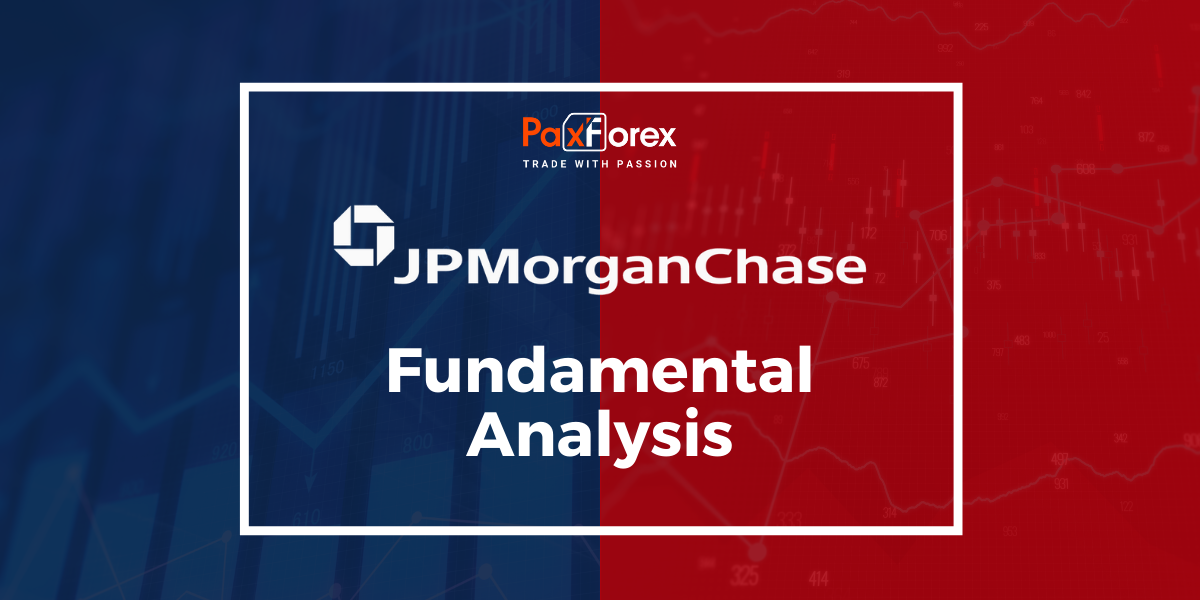
Source: PaxForex Premium Analytics Portal, Fundamental Insight
Over the last few months, the stock market for banks has experienced significant fluctuations, driven by various factors such as interest rates, economic conditions, and notable bank failures. However, it is important to recognize that not all banks have been affected in the same way. Despite the volatility, many major banks have managed to navigate through these challenging times and even achieved positive financial results.
Among the top performers in the previous quarter, JPMorgan Chase, the largest bank in the United States, stood out. As we enter the uncertain second half of 2023, it is worth examining the position of this influential player in the industry. Furthermore, investors may wonder whether this particular stock is a wise investment choice.
JPMorgan Chase stood out as one of the most resilient large banks in the country even before the regional banking crisis unfolded in March. In fact, it appears that the bank may have emerged from that period of turmoil even stronger. Several key factors contribute to this assessment, which we will explore further.
Firstly, while many banks experienced a decrease in deposits, JPMorgan Chase witnessed a notable 2% increase in Q1 compared to the previous quarter, bringing the total to $2.4 trillion. This growth in deposits can be attributed to concerns among customers of smaller and regional banks, who feared widespread deposit runs following the collapses of Silicon Valley and Signature banks. Consequently, these customers sought refuge in larger institutions, driven by a flight towards perceived safety and stability. JPMorgan Chase, being a well-capitalized, highly liquid, and heavily regulated bank, became an attractive option for depositors seeking these qualities.
The flight to safety observed during the challenging period proved beneficial for JPMorgan Chase, resulting in a strong performance during the first quarter. The company experienced a significant 25% increase in net revenue, amounting to $39.3 billion, driven primarily by a substantial 49% year-over-year growth in net interest income. Notably, JPMorgan Chase's executives shared during their investor day on May 22 that the bank is on track to add 1.8 million accounts this year, surpassing the previous year's gain of 1.6 million accounts.
The bank's net income demonstrated remarkable progress, rising by 52% compared to the previous year and 15% compared to the fourth quarter, reaching $12.6 billion. This growth can be attributed to positive developments in consumer banking, commercial banking, and asset and wealth management, which offset declines in investment banking. Additionally, JPMorgan Chase achieved an impressive efficiency ratio, with overhead costs as a percentage of revenue improving from 62% in Q1 of the previous year to a commendable 52%, the best performance among large banks (lower values are preferable). Moreover, the bank's overall return on equity, a measure of management efficiency, surged from 13% a year ago to 18% by the end of the first quarter.
While JPMorgan Chase may face challenges in the event of an economic slowdown or recession, it possesses key strengths that allow it to navigate short-term volatility. These strengths include operational efficiency, a high Common Equity Tier 1 ratio of 13.9%, a rising book value (up 9% year over year), and a substantial $1.4 trillion in cash and marketable securities. These factors contribute to the bank's fortress-like balance sheet, providing resilience in difficult market conditions.
Moreover, JPMorgan Chase is well-positioned for growth opportunities beyond any potential downturn. As the markets improve, the bank is expected to experience long-term gains in investment banking, trading, and asset management. Additionally, the acquisition of First Republic Bank, a bank serving high-net-worth clients, is anticipated to enhance JPMorgan Chase's annual profit by $500 million, acting as a catalyst for further growth.
The company also foresees greater net interest income (NII) than initially projected. JPMorgan Chase raised its NII forecast for 2023 to $81 billion, up from the previous estimate of $80 billion. This upward revision is based on the assumption that deposit and other funding costs will decrease, driven by expected interest rate reductions by the Federal Reserve later in the year.
Furthermore, JPMorgan Chase's stock is currently relatively inexpensive, with a price-to-earnings ratio of approximately 10. This makes it an appealing investment choice, as the bank is well-equipped to handle short-term challenges while aiming for long-term growth.
Overall, considering its resilience, growth prospects, and favorable valuation, JPMorgan Chase appears to be an excellent buy at present, offering a combination of stability and potential for long-term gains.
As long as the price is above 132.00, follow the recommendations below:
- Time frame: D1
- Recommendation: long position
- Entry point: 135.39
- Take Profit 1: 144.00
- Take Profit 2: 150.00
Alternative scenario:
If the level of 132.00 is broken-down, follow the recommendations below:
- Time frame: D1
- Recommendation: short position
- Entry point: 132.00
- Take Profit 1: 128.00
- Take Profit 2: 123.00













